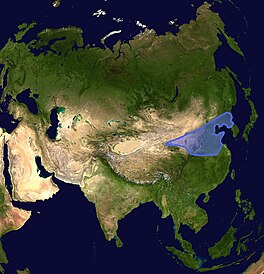

The North China Craton is a continental crustal block with one of Earth's most complete and complex records of igneous, sedimentary and metamorphic processes.[1] It is located in northeast China, Inner Mongolia, the Yellow Sea, and North Korea.[1] The term craton designates this as a piece of continent that is stable, buoyant and rigid.[1][3][4] Basic properties of the cratonic crust include being thick (around 200 km), relatively cold when compared to other regions, and low density.[1][3][4] The North China Craton is an ancient craton, which experienced a long period of stability and fitted the definition of a craton well.[1] However, the North China Craton later experienced destruction of some of its deeper parts (decratonization), which means that this piece of continent is no longer as stable.[3][4]
The North China Craton was at first some discrete, separate blocks of continents with independent tectonic activities.[5] In the Paleoproterozoic (2.5-1.8 billion years ago) the continents collided and amalgamated and interacted with the supercontinent, creating belts of metamorphic rocks between the formerly separate parts.[5] The exact process of how the craton was formed is still under debate. After the craton was formed, it stayed stable until the middle of the Ordovician period (480 million years ago).[4] The roots of the craton were then destabilised in the Eastern Block and entered a period of instability. The rocks formed in the Archean and Paleoproterozoic eons (4.6–1.6 billion years ago) were significantly overprinted during the root destruction.
Apart from the records of tectonic activities, the craton also contains important mineral resources, such as iron ores and rare earth elements, and fossils records of evolutionary development.[6]
- ^ a b c d e f Cite error: The named reference
orogen to craton to orogenwas invoked but never defined (see the help page). - ^ Zhao, Guochun; Sun, Min; Wilde, Simon A.; Sanzhong, Li (2005). "Late Archean to Paleoproterozoic evolution of the North China Craton: key issues revisited". Precambrian Research. 136 (2): 177–202. Bibcode:2005PreR..136..177Z. doi:10.1016/j.precamres.2004.10.002.
- ^ a b c Jordan, Thomas H. (1975-07-01). "The continental tectosphere". Reviews of Geophysics. 13 (3): 1–12. Bibcode:1975RvGSP..13....1J. doi:10.1029/rg013i003p00001. ISSN 1944-9208.
- ^ a b c d Zhu, Ri-Xiang; Yang, Jin-Hui; Wu, Fu-Yuan (2012). "Timing of destruction of the North China Craton". Lithos. 149: 51–60. Bibcode:2012Litho.149...51Z. doi:10.1016/j.lithos.2012.05.013.
- ^ a b Zhao, Guochun; Zhai, Mingguo (2013). "Lithotectonic elements of Precambrian basement in the North China Craton: Review and tectonic implications". Gondwana Research. 23 (4): 1207–1240. Bibcode:2013GondR..23.1207Z. doi:10.1016/j.gr.2012.08.016.
- ^ Cite error: The named reference
Depositional history, tectonics, and provenancewas invoked but never defined (see the help page).